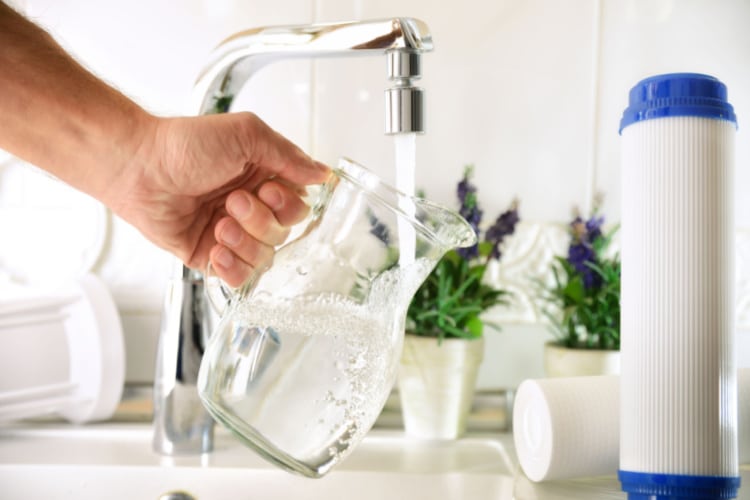Reverse osmosis is a popular water purification process that uses pressure to filter water through a semi-permeable membrane. RO water generally tastes better than tap water since it filters the minerals & contaminants that makes water taste bad, however, it’s not uncommon for the filtered water to still have a funny taste despite going through several filtration stages.
So, why does reverse osmosis water taste funny? If your RO water tastes bad, then it’s a sign that the RO system is malfunctioning or lacks proper maintenance. You should replace the filters every 6 – 12 months or completely change the membrane if it’s bad.
What Does Reverse Osmosis Water Taste Like?
Water that’s purified through reverse osmosis doesn’t have a particular taste but it’s one of the cleanest drinking water since 92-99% of the minerals that give water its taste are filtered out during the process. Most people who filter their water with RO systems say that there’s hardly any taste to it.
Most RO systems operate in the following stages:
- The sediment filter removes particles such as dirt, dust, and rust.
- The carbon filter removes chlorine and other contaminants that give water a bad taste.
- The semipermeable membrane is the component that filters out roughly 98% of all TDS (total dissolved solids).
The end result of this multi-stage purification is tasteless water, which also makes it very easy for you to determine when there’s something wrong with the system. For example, if your drinking water tastes salty, metallic, acidic, or like rotten eggs, it’s a sign that something is awry and needs attention or replacement.

What Makes RO Water Taste Bad?
Reverse osmosis systems are not fail-safe, and can malfunction if not properly taken care of. Therefore, it’s imperative to regularly check the filters as well as other components and replace them when necessary, in accordance with your product manual. RO membranes need to be replaced every 2–5 years, while a new filter is necessary once every 12 months.
That being said, a malfunctioning system isn’t the sole reason for bad taste in drinking water. Below are five other reasons why reverse osmosis water can taste funny, how you can identify them, and solutions for each of these problems.
RO Water Tastes Salty:
An RO system removes salt solids from water during the purification process. However, if your filtered water still tastes salty, it’s most likely due to highly concentrated chloride ions or sodium sulfates that made their way into the water. Systems with lesser capacity and old filters aren’t capable of handling such high concentrations.
If you live near the seaside, your water is more likely to taste salty due to the chloride ions seeping into your water supply, thereby increasing the salt concentration. As a result, less capable filtration systems or worn-out filters can’t eliminate all the salinity.
Sulfates, on the other hand, are natural minerals that can be found anywhere on Earth and can end up in your water externally. The ground in your area might sometimes absorb too much salt, especially during droughts or dry spells, which then leaks into your area’s water table, reservoir, or even your well once they recede.
Near farmlands, runoff fertilizer might infiltrate your water supply, causing a spike in salinity to the extent that RO systems can’t handle it either.
Not only does salty water taste bad, but too much salt in your water can also cause a host of health issues. High blood pressure, which increases the risk of developing hypertension or prehypertension, is one of common health issues.
Solution:
The best solution is to ensure your RO system is functioning properly and regularly change your filters. When salinity levels in the water increases, your filter works harder and may need to be changed more frequently than 12 months. If the salt taste persists after the filter replacement, it might be best to invest in a more capable RO system like the Waterdrop G3 800 or Aquatru.
RO Water Tastes Like Metal
If the filtered water tastes like metal, it’s either due to extremely high levels of TDS or because the acidic RO water corroded the copper tubes of the filtration system. If your system has copper tubes connecting to your faucet, it’s even more prone to corrosion.
The copper rust will then end up in the drinking water since it’s already past filtration, causing it to taste like metal.
Although the filtration process gets rid of most contaminants, some TDS might still end up in your glass due to extreme concentration or incapable filters. Total dissolved solids like sulfates, bicarbonates, and chloride can also produce a metallic taste.
Solution:
The first step in dealing with this particular issue is to check the filters and tubes to identify the source of the problem. Replace them if they’re worn out enough to allow TDS in.
If the problem stems from the worn-out filters, replace them or get a more powerful filtration system. On the other hand, if there’s corrosion in the tubes, replace the copper with polyethylene that’s more resistant to salts, acids, and alkalis.
In addition, you can consider investing in an RO system that has a re-mineralizer. It’ll re-introduce minerals lost to the semi-permeable membrane into the water and will reduce its acidity.

RO Water Tastes Like Regular Tap Water
If your RO water tastes the same as unfiltered tap water, it probably means that the RO membrane isn’t working properly. The membrane could be damaged, completely deteriorated or ruptured.
The semi-permeable membrane can last 2–3 years. However, its lifespan shortens considerably if water that passes through the membrane is highly contaminated, or if the other filters in the system aren’t regularly maintained and replaced.
The symptoms of a bad membrane aren’t just limited to bad water taste. Discolored look or foul smell are also common signs to lookout for.
Solution:
The only solution is to replace the membrane. If the smell doesn’t subside or if the water still tastes like regular tap water, you can also change the other filters in system just to make sure.
RO Water Smells like Rotten Eggs
The rotten egg taste and smell are mostly caused by high levels of hydrogen sulfide (sulfur) in water. A functional RO system with good filters should be able to take care of this gas. If your RO filtered water smells like rotten eggs, the conclusion is simple: the system isn’t filtering hydrogen sulfide anymore.
In municipal systems, chlorination is used to remove hydrogen sulfide, but that’s rarely the case for those who use well water. Therefore, this particular problem occurs more frequently in rural areas where water comes straight from the ground.
Solution:
If the system has gone through a period of less frequent use or hasn’t been properly sanitized, the best thing to do is thoroughly wash/clean it. This can help it properly filter hydrogen sulfide.
If you don’t live in a rural area and your reverse osmosis water tastes like sulfur, it could mean there was a drastic change in the incoming water quality. Taste the regular tap water to check for any changes, then contact your local municipal water provider for more information.